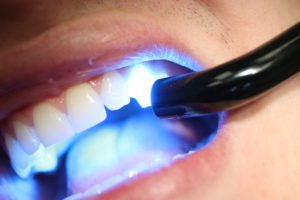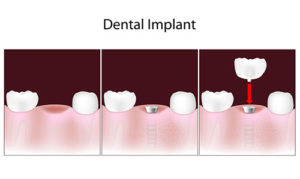Preventative Care
Dental Cleaning
Routine dental cleanings are essential to maintaining good oral hygiene. Professional cleaning by a dental hygienist can remove mineralized plaque that may develop even with careful brushing and flossing, particularly in areas that are difficult to reach.
Routine dental exams are important to maintaining healthy teeth and gums. Additionally, they can help to avoid the financial costs associated with large treatment plans later on. By completing twice yearly checkups, most problems can be caught while they remain in an early stage.
Fluoride can help repair an early cavity, even before it has become visible in the mouth, by rebuilding the enamel layer of the tooth. Fluoride is also helpful in older adults, to help solve the problem of cavities in the tooth root or root sensitivity.
Sealants are a clear plastic resin coating, like nail polish, that forms a physical barrier to oxygen. Sealants “starve” the bacteria that cause tooth decay. We apply sealants on the back teeth where pits and grooves typically form. This painless treatment helps prevent cavities and can last for years.
General Dentistry Procedures
Composite Fillings
 When treating a cavity, the dentist will remove the decayed portion of your tooth and fill it with another substance. This procedure is called a filling. There are multiple options for the material to be used in the filling, the most common of which are composite fillings and amalgam fillings.
When treating a cavity, the dentist will remove the decayed portion of your tooth and fill it with another substance. This procedure is called a filling. There are multiple options for the material to be used in the filling, the most common of which are composite fillings and amalgam fillings.
A composite filling is also known as a tooth colored filling, since the material used in the filling can be closely matched to the color of your teeth. Composite fillings provide good durability for small to medium cavities, and the procedure typically involves removing less of a tooth than you would during an amalgam filling. They are also particularly well suited for treating front or highly visible teeth because of their natural look.
Implants
 Dental Implants are a great advancement in dentistry as they permanently replace missing teeth in a way that no previous dental technique was able to accomplish. Implants are anchors made out of the strongest titanium materials, that are implanted into the bone and then covered with a cap or denture. They are stronger than a natural root and will never require a root canal or filling. An implant will help maintain the health and shape of the bone in the jaw area, and neighboring teeth do not need to be filed down to make room for it.
Dental Implants are a great advancement in dentistry as they permanently replace missing teeth in a way that no previous dental technique was able to accomplish. Implants are anchors made out of the strongest titanium materials, that are implanted into the bone and then covered with a cap or denture. They are stronger than a natural root and will never require a root canal or filling. An implant will help maintain the health and shape of the bone in the jaw area, and neighboring teeth do not need to be filed down to make room for it.
It is imperative that the dentist performing the implant be experienced and skilled in all the proper techniques of implant dentistry. When done successfully, an implant will result in a comfortable and natural looking tooth, thereby providing a permanent solution to a missing tooth
Root Canal Therapy
Root canal therapy is a treatment used to repair and save a tooth that has been infected due to a deep cavity or cracked tooth. The treatment involves removing the pulp and the nerves of the tooth, and cleaning the infected area. The term “root canal” comes from cleaning of the canals inside the tooth’s root.
Tooth Extractions
A dental extraction is the procedure to remove a tooth from your mouth. A dental extraction is most commonly required if one of your teeth is damaged beyond practical repair. The most common reasons for tooth extractions include:
- Severe tooth decay or infection may make it impossible or too costly to repair a tooth
- Advanced gum disease may require a tooth to be pulled so it doesn’t affect the supporting tissues and bone structures of your mouth
- A tooth may be extracted if it is blocking other teeth from coming in
- During orthodontic work, teeth may need to be extracted to create room for the teeth that are being moved into place
- Wisdom teeth are often extracted either before or after they come in
Dentures
Dentures are used to replace missing teeth or damaged teeth that cannot be otherwise repaired. Replacing missing teeth will help to improve your appearance and smile. Dentures are custom-made in a dental laboratory from impressions taken of your mouth and can help you eat and speak more comfortably.
Cosmetic Dentistry
Invisaline®
Invisalign® is a modern alternative to straighten your teeth without wires or metal. Invisalign® involves a series of custom trays designed specifically for you and the plan your dentist or orthodontist creates to move your teeth. The trays are made from a smooth plastic that covers your teeth and gradually moves them into place.
Unlike braces, there are no brackets to tighten. Instead, you use different trays as your teeth move into position. Typically trays are changed every two weeks. Invisalign® is a popular choice for straightening because it involves minimal disturbance to your daily routine or appearance. The trays are difficult to see and most people will have no idea you are wearing them.
If you have considered straightening your teeth, contact us today to learn more about Invisalign® and how it can benefit you.
Porcelain Crowns
Compared to fillings which cover a small portion of a tooth, a crown (or cap) encases the entire visible portion of a tooth. In effect, the crown acts as the tooth’s new outer surface.A dental crown is used when a tooth is broken or decayed to such an extent that fillings aren’t able to repair the problem. The crown is able to provide a protective shell around the damaged or decayed tooth to strengthen it, as well as to improve the appearance of the tooth. They can also help restore a tooth to it’s original shape, are used commonly for teeth that have been broken. While crowns come in different materials, the most common crowns typically have some mixture of porcelain in them to give them a look and feel similar to a natural tooth.
Teeth Whitening
Our teeth can discolor through the years as our enamel wears down. The wearing down of enamel allows dentin, a yellow color substance that makes the core of our teeth, to show through. This is what gives our teeth a yellowish tint. Teeth whitening helps restore teeth and create a brighter smile.
Dental Bridges
A dental bridge is a false tooth that is used to fill the gap created by a missing tooth or teeth. A gap between your teeth can be potentially dangerous to your dental health, as it can cause your teeth to shift, resulting in a change in your bite. Dental bridges help alleviate this problem by using the two surrounding teeth as anchors to hold a false tooth where the gap is.
Dental Veneers
Dental veneers are thin custom made shells that cover the front surface of your tooth to improve their appearance. They are made of tooth colored materials and can be used to improve the color of teeth that have been worn down or stained. Alternatively, they can be used to improve the shape or size of the tooth.
Dental Bonding
Dental Bonding is a restoration procedure in which a tooth-colored resin is bonded to a tooth and cured with ultraviolet light. Bonding is faster and cheaper than veneers or crowns, and can thus be a good option to make small cosmetic improvements to your teeth. Unlike veneers and crowns, bonding can be done within one office visit since nothing has to be custom made by a dental laboratory. Additionally, the procedure typically requires removing less of the tooth enamel compared to veneers and crowns. However, since bonding typically doesn’t last as long as other forms of restoration and is less resistant to stains, it is used more often for small cosmetic touchups rather than major restorations.
Dental Inlays and Onlays
Dental inlays and onlays are a more conservative approach to tooth restoration than full crowns. They are used to repair rear teeth that have mild to moderate tooth decay, or for cracked teeth where the damage does not warrant a dental crown. Porcelain, composite resin and sometimes gold are used to create inlays and onlays. Inlays refer to those procedures where the bonded material is limited to the center of the tooth, while onlays refer to those procedures where the bonded material can extend further to one or more cusps of the tooth.

